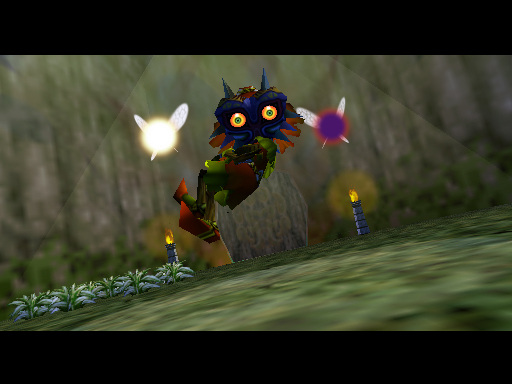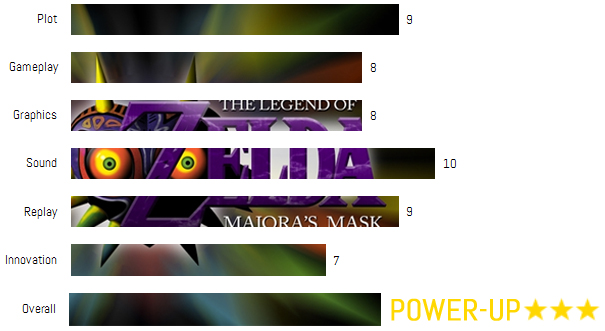The Legend of Zelda: Majora’s Mask is the sixth instalment in Nintendo’s The Legend of Zelda series and one of the few to not take place in Hyrule. Instead, Link travels to the land of Termina to stop a creepy moon from falling from the sky and exterminating all life.
ROUND-UP:
REVIEW-UP:
After the success of The Legend of Zelda: Ocarina of Time, work began on a new game in the series and this was tentatively titled ‘Ura Zelda’ or ‘Another Zelda’. The smaller team for its development was meant to finish its work in one year. Faced with the difficulty creating a follow-up to the highly successful Ocarina of Time, they decided on the title’s three-day period in order to make it smaller while still allowing for depth of gameplay.
I came to The Legend of Zelda: Majora’s Mask after having enjoyed the previous game and replaying it over and over again. The thought of following that Link into another story was exciting. I thought I’d find the familiar Hyrule beset by another onslaught of darkness, but instead found Termina and its giant creepy moon looming over it. It wasn’t what I expected but in the end I replayed this title as much as I did its predecessor.
The start of the game finds Link traveling through the Lost Woods with Epona when they suddenly meet the Skull Kid wearing Majora’s Mask, who promptly takes the Ocarina of Time. Our hero lunges to recover it but the strange child takes the horse and rides away; and whilst in pursuit, Link falls into a hole in a way reminiscent to Alice in Wonderland and ends up in Termina. When they next meet, the Skull Kid curses link and turns him into a Deku Shrub and leaves, telling him he’d disposed of Epona. Upon exiting the strange caves he landed in, Link finds himself in Clock Town and soon discovers the moon has left its orbit and will crash into Termina in three days – and it’s now up to him to stop that from happening.
Majora’s Mask used the Nintendo 64’s expansion pack and so the visual quality surpassed that of Ocarina of Time. Termina’s design is both awe inspiring and downright creepy: the moon’s manic face keeps you unnerved every minute of play; mask transformation sequences are downright scary; and Termina’s different regions are wastelands. The titles visuals reinforce the land’s impending doom. Music design follows the same queues and while there are upbeat tones, and Termina field’s theme song is a remix of the original Zelda’s theme and there’s a gloomy sense in the entire soundtrack. The Skull Kid’s laugh is one of the creepiest sounds in all of the series and the ‘last hours’ of the third day have such an eerie track your hairs will stand on end. Best of all, the new fairy jingles like a bell instead of Navi’s infamous ‘Hey, listen!’

As you may have guessed, the tone of this Zelda is significantly darker. The plot is grim but it’s never depressing, as the game does things right in giving you plenty of lightheartedness to contrast the gloom and this makes the creepy parts much more effective. It’s wonderful and gripping storytelling. Each zone has its own subplot aside from the dungeon and the Zora zone is particularly dark, with the mask ‘source’ being a dying creature whose tormented spirit you help to pass on with the Ocarina of Time.
Gameplay remains largely unchanged from the previous title. You still move with the stick, map items to buttons with ‘A’ being the primary action button and ‘Z’ used to lock-on to enemies and important objects. The Ocarina of Time is once again present, as are songs with different effects, though we’ll talk about that later. The atrocious wallet mechanic comes back as well… sadly.
The masks in Majora’s Mask greatly expand gameplay, however. As with the previous title there are cosmetic masks, which require subquests of increasing complexity; but there are also transformation items that turn Link into a Goron, Zora or Deku Scrub (or a badass version of Link wielding a two-handed sword, if you collect all other masks before the end of the game). They are all fantastic! Swimming like a Zora, gliding on petals with the Scrub and rolling around like a Goron are so much fun you’ll spend hours doing them. I did, rolling around Termina field as much as I could.
Songs make a comeback with the Ocarina, and the Song of Time in particular is a central mechanic as it allows you to reset time, speed or even slow it. The Song of Soaring allows for quick travel between owl statues, a mechanic that would return in a similar fashion in The Legend of Zelda: Skyward Sword and The Legend of Zelda: A Link Between Worlds. An interesting point is that when transformed with the different masks, the Ocarina changes to a shape matching that form such as an electric guitar for the Zora.
The most important part, however, is the three-day cycle and its mechanics. It’s impossible for Link to complete his quest in the actual three days so he must play his own version of Groundhog Day and revert time back to the first day. He keeps all his gear but loses all money (unless you store it in the bank for some mysterious reason) and ammunition. While the Boss Masks stay in his inventory as proof of his progress, the dungeons themselves reset and you can replay and fight the boss once more, using the mask to skip ahead to its chamber.
Time management is important and you must be careful on what you use your time on, otherwise you run the risk of wasting a cycle. The interesting part is you’re not the only one with a schedule to keep. Every NPC has its own schedule and tasks they perform during the three days and at appointed times. This ties in with most of the subquests, as you sometimes need to interact with NPCs over the course of a cycle at specific times to get a mask.

The only downsides in this otherwise magnificent game everyone should play are: firstly, its reuse of Ocarina of Time assets. This is understandable since Majora’s Mask started as ‘Ura Zelda’, a ‘second quest’ type of title that would eventually release as the Master Quest, and the short development time. Secondly, the three-day cycle can get rather tedious after a while. As for my criticism on lack of difficulty in Ocarina of Time, I can happily say Majora’s Mask doesn’t repeat its predecessor’s mistakes and the difficulty ramps up progressively. The fight with the Skull Kid and Majora’s Mask are extremely difficult.
While it is true that the cycles can get tedious, the mask subquests add plenty of replayability to this game, as very few will acquire all the masks, and the Fierce Deity Mask in the end, during their first playthrough. And that is without counting the Heart Piece collection, equipment upgrades, bottle collection and even helping all of the Great Fairies. The game might be smaller than Ocarina of Time in many ways, but it didn’t lose to its predecessor in terms of replayability.

With so many things copied from Ocarina of Time you might think this game didn’t innovate much, but you would be mistaken. The grim plot was Majora’s Mask’s first innovation as it showed the Zelda series was capable of much darker storytelling, and without it we probably wouldn’t have had the very dark The Legend of Zelda: Twilight Princess. In this game you also transform into a Wolf, and Majora’s Mask was the first to show Link transforming into other forms at will (unlike the bunny in A Link to the Past, which was against your will). And for better or worse, Majora’s Mask introduced us to Tingle, the would-be fairy.
It’s an outstanding game and one of the jewels of the Zelda series, made even more amazing by its relatively short development time. This is a must-play game, not only just fans of the franchise but for everyone. You won’t be disappointed by the powerful story and addictive gameplay.
RATING-UP:
How did we reach these scores? Click here for a guide to our ratings.



I have very fond memories of playing Majora’s Mask as a kid. It was the only game at the time that literally gave you a time limit to complete it.
Great review!
I am still hoping Nintendo will release a remake soon.
Differently from you, though, I loved the 3-day cycle mechanic. It added incredible urgency to the gameplay, which goes along nicely with the game’s dark tone.
The mask-collecting featured, and the clock-based character behavior, supported the creation of some incredible sidequests, which is probably the game’s strongest feature.
Majora’s Mask also presents what, to me, is the greatest Zelda dungeon ever: the Stone Tower Temple. It’s a masterpiece in design, and I think the same can be said about the Great Bay Temple.